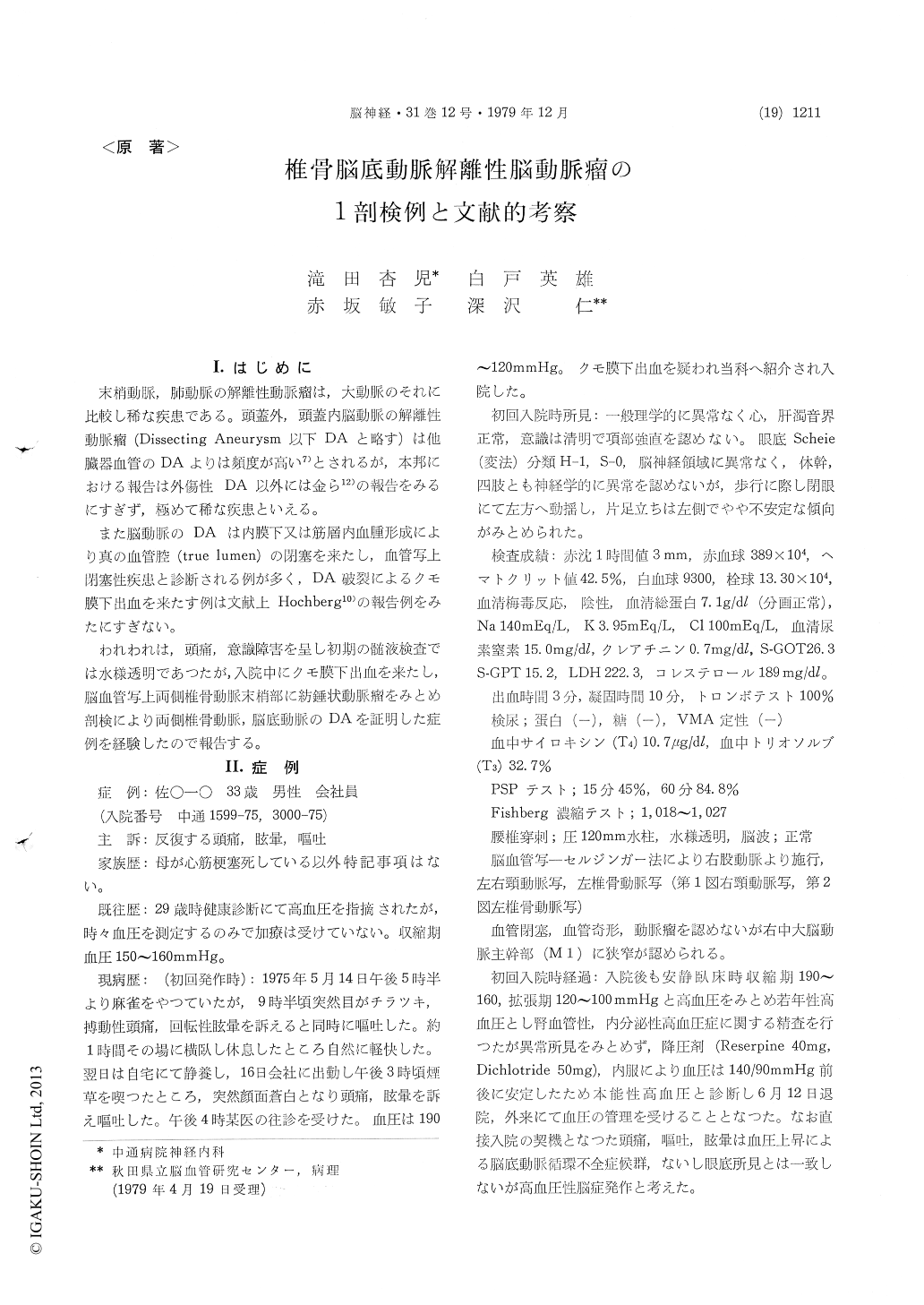Japanese
English
- 有料閲覧
- Abstract 文献概要
- 1ページ目 Look Inside
Ⅰ.はじめに
末梢動脈,肺動脈の解離性動脈瘤は,大動脈のそれに比較し稀な疾患である。頭蓋外,頭蓋内脳動脈の解離性動脈瘤(Dissecting Aneurysm以下DAと略す)は他臓器血管のDAよりは頻度が高い7)とされるが,本邦における報告は外傷性DA以外には金ら12)の報告をみるにすぎず,極めて稀な疾患といえる。
また脳動脈のDAは内膜下又は筋層内血腫形成により真の血管腔(true lumen)の閉塞を来たし,血管写上閉塞性疾患と診断される例が多く,DA破裂によるクモ膜下出血を来たす例は文献上Hochberg10)の報告例をみたにすぎない。
A intracranial dissecting aneurysm is exceedingly rare condition as compared as dissecting aneurysm of the aorta. A case of dissecting aneurysm of the vertebro-basiral artery with episodes of TIA, terminally subarachnoid hemorrhage was reported.
A 33-year-old man was admitted to Nakadohri Hospital on Oct. 12, 1975, with complaints of headache, vomiting and weakness of the left upper and lower extremities. He had a history of essential hypertension and episodes of transient attack of blurred vision, headache and vomiting before four months.
On examination, he was drawsy and slightly confused. Blood pressure was 223/130 mmHg, pulse rate 81. Neurologically, he had a minimal left hemiparesis with bilateral Babinski sign and his eyes were deviated to the right. The spinal tap revealed clear, colorless CSF with an open pressure of 120 mm of water. The right carotid angiography performed soon after admission showed slight narrowing of the trunk of middle cerebral artery.
The hemiparesis was gradually improving but on Oct. 14, he suddenly complained of severe headache and then he was comatose. The spinal tap soon after the attack revealed bloody CSF. An emergency selective left vertebral angiogram disclosed fusiform-aneurysms of terminal portions of the bilateral vertebral arteries and occlusion of the left posterior cerebral artery. He died 4 days after the last attack.
Autopsied brain revealed marked subarachnoid hemorrhage in the base of the pons and frontal base. The vertebral arteries were dilated at the prejunctional portions.
The coronal section of the brain disclosed edematous swelling and hemorrhagic infarction in the territory of the left posterior cerebral artery.
Microscopically, the basiral artery was dissected between media and adventitia and the true lumen was compressed by hematoma in dissecting false lumen. There were marked thrombotic stenoses of the trunks of anterior, middle, and posterior cerebral arteries. The cause of the dissecting aneurysm of this case was not obscure but arterio-sclerosis and congenital defect of internal lamina was suspected.
The disease in the literature, presented an acute onset of stroke and stenotic or complete occlusive lesions were demonstrated on angiogram. The true subarachnoid hemorrhage of intracranial dissecting aneurysm was rare condition such as our case.

Copyright © 1979, Igaku-Shoin Ltd. All rights reserved.


